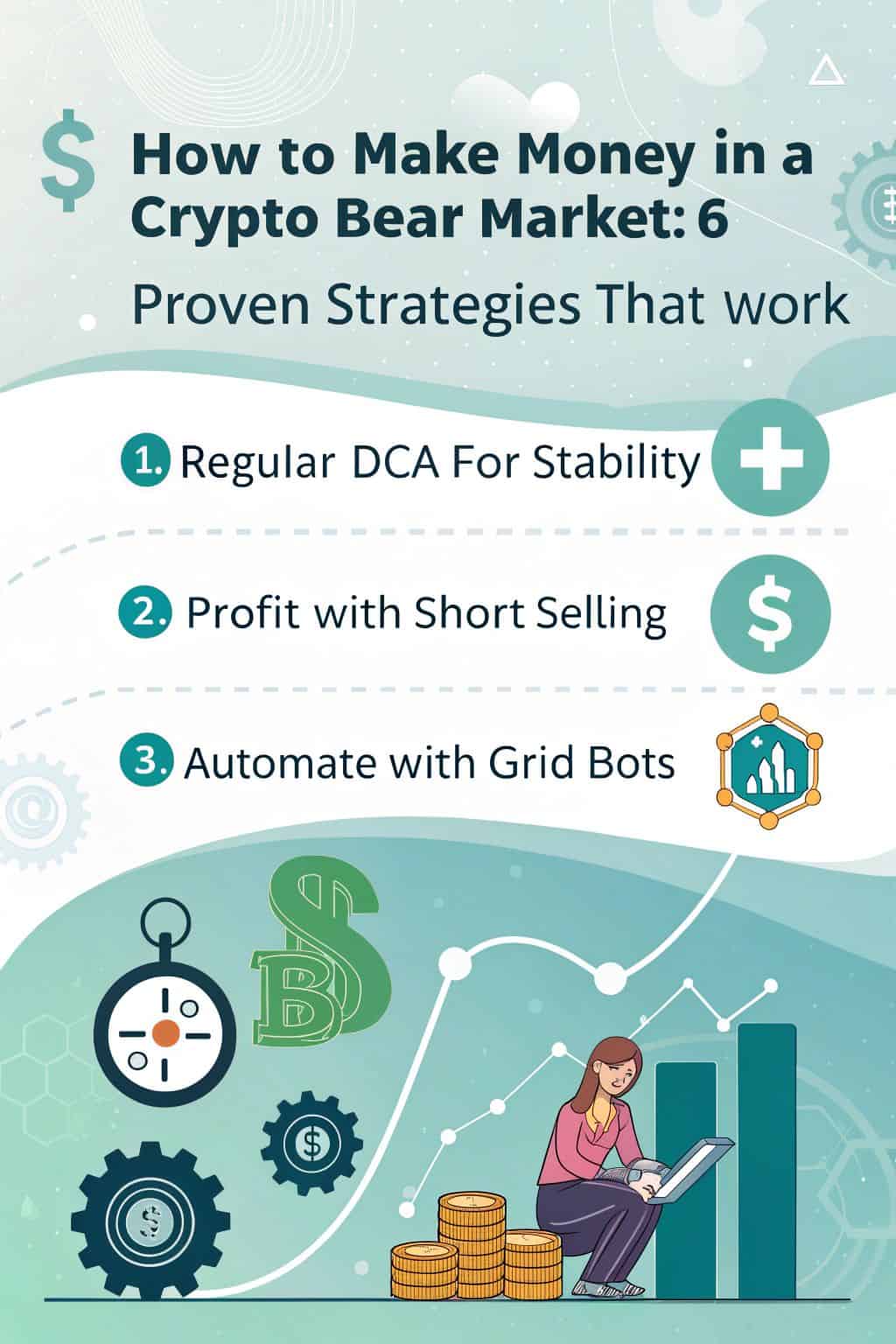Crypto bear markets can be tough. Prices drop, and many investors lose money. But smart traders know how to profit even when markets fall. This guide shows you how to make money in a crypto bear market.
We’ll cover six proven strategies that work. Ready to turn the bear market into your playground?
Key Takeaways
Crypto bear markets can last months or years, with prices dropping 20% or more in 60 days and up to 85% in 10 weeks.
Dollar-cost averaging (DCA) helps balance market swings by investing a set amount regularly, regardless of price.
Short selling, staking, yield farming, and crypto savings can offer ways to profit during downturns, with some platforms offering up to 15% APY on stablecoins.
Grid bots automate trades within a set price range, helping capture small gains repeatedly during market volatility.
Diversifying your crypto portfolio, setting stop-loss orders, and using hedging techniques like options trading can help manage risk in bear markets.
Table of Contents
Exploring the Dynamics of a Crypto Bear Market

Crypto bear markets can shake up even the toughest traders. These downturns often last months or years, testing the patience of investors big and small.
Definitions and Key Characteristics
 Crypto bear markets are challenging periods for investors. Prices decline rapidly, often by 20% or more in just 60 days. Bitcoin’s Bitcoin price has experienced significant drops during these periods.
Crypto bear markets are challenging periods for investors. Prices decline rapidly, often by 20% or more in just 60 days. Bitcoin’s Bitcoin price has experienced significant drops during these periods.
Investors become anxious and sell, which further drives prices down. It creates a cascading effect, intensifying the market downturn.
Key indicators of a bear market include low confidence and widespread apprehension. Investors become concerned about potential losses. They tend to avoid risks and maintain cash positions.

In some instances, prices can decrease by up to 85% in just 10 weeks. That’s a substantial decline! I observed my portfolio diminish during the previous bear market. While it was challenging, it provided valuable lessons about maintaining composure during market turbulence.
In a bear market, money returns to its rightful owners. – Warren Buffett
Typical Causes and Catalysts

Bear markets in crypto often stem from a mix of factors. Big security breaches can spook investors, leading to panic selling. For example, when hackers stole millions from exchanges, prices tumbled as trust eroded.
High leverage also plays a role. Many traders use borrowed money to buy crypto. When prices drop, they’re forced to sell, pushing prices down more.
Market liquidity dries up in bear markets too. Fewer buyers mean assets can’t be sold easily. This makes price drops worse. Outside forces matter as well. New laws or bans on crypto can scare off investors fast.
Stock market dips often drag crypto down with them. As traditional markets struggle, people pull money from riskier assets like Bitcoin. I’ve seen firsthand how quickly sentiment can shift when these factors align.
Maximizing Profits During a Crypto Bear Market

Making money in a crypto bear market isn’t easy, but it’s possible. Smart traders use special tricks to grow their wealth even when prices drop. Let’s explore some proven ways to boost your profits during tough times.
Employing Dollar-Cost Averaging

Dollar-Cost Averaging (DCA) is an effective approach to purchasing cryptocurrency during a bear market. The concept is straightforward: you invest a set amount regularly, regardless of the price.
This strategy helps balance out market fluctuations. You acquire more when prices are low and less when they’re high. It’s an excellent method for passive investors who prefer not to worry about market timing.
I’ve implemented DCA myself, and it has significantly improved my investment approach. It removes emotional decision-making from investing and assists me in maintaining focus on my long-term objectives.
To begin, select an asset (such as Bitcoin), determine an amount (for example, $100), and decide on a purchase frequency (weekly or monthly). Then, select a reputable exchange and secure storage.
DCA can be an effective strategy even during a crypto bull run.
DCA is akin to a steady ship in a stormy sea – it maintains your course when the market becomes turbulent.
Utilizing Short Selling Techniques
 Short selling can be an effective strategy in a bear market. It allows you to profit when crypto prices fall. You sell borrowed coins at a high price and buy them back cheaper later.
Short selling can be an effective strategy in a bear market. It allows you to profit when crypto prices fall. You sell borrowed coins at a high price and buy them back cheaper later.
The difference is your profit. However, this approach requires expertise and readiness for significant price fluctuations.
Various methods exist for shorting crypto. You can use margin trading on exchanges like Binance. Futures contracts and options are other possibilities. Some DeFi platforms also provide shorting tools.
Be aware that shorting carries substantial risks. You could lose more than your initial investment if prices increase sharply. Next, we’ll explore how staking can help you earn in a down market.
Engaging in Crypto Staking

Moving from short selling, let’s explore a less risky way to earn in a bear market: crypto staking. This method lets you lock up your tokens and earn rewards. It’s like putting money in a savings account, but with higher returns.
Platforms such as Ka.app offer up to 15% APY on KASTA tokens. That’s a big boost compared to traditional banks.
Staking does more than just earn you money. It helps secure the network and gives you a say in how it runs. Your locked tokens act as a vote in the system’s governance. But keep in mind, you can’t touch your staked assets for a set time.
This lock-up period varies by platform. Still, the rewards can help offset losses from falling token prices. It’s a smart way to make your crypto work for you, even when the market’s down.
Exploring Yield Farming and Liquidity Mining
 Yield farming and liquidity mining offer ways to earn in a bear market. These methods involve staking or lending crypto on DeFi platforms for rewards. Popular protocols like Aave, Pancakeswap, and Uniswap let users lock up their assets to gain extra tokens.
Yield farming and liquidity mining offer ways to earn in a bear market. These methods involve staking or lending crypto on DeFi platforms for rewards. Popular protocols like Aave, Pancakeswap, and Uniswap let users lock up their assets to gain extra tokens.
In 2023, yield farming added nearly $8 billion to the crypto space.
But watch out! These strategies come with risks. Rug pulls, where devs vanish with funds, can happen. Market swings and unclear rules also pose threats. Still, for crypto geeks who do their homework, yield farming might be worth a shot.
Just don’t bet the farm on it!
Considering Crypto Savings and Lending Options

Crypto savings and lending offer ways to earn passive income in a bear market. You can lend your crypto to others and earn interest, often at higher rates than traditional banks. Some platforms offer up to 15% APY on stablecoins.
I’ve used BlockFi to earn 8% on my USDC holdings during downturns. It’s a solid way to grow your stack when prices are low.
Lending isn’t without risks, though. Always research platforms carefully and don’t lend more than you can afford to lose. Start small and spread your funds across multiple services to lower risk.
As the saying goes:
Don’t put all your eggs in one basket.
This applies to crypto lending too. By being smart about savings and lending, you can make your crypto work for you even in tough markets.
Implementing Scalp Trading with Grid Bots
Grid bots are game-changers for crypto traders in bear markets. These smart tools set up a price range and make trades within it. They grab profits from price swings during wild market times.
I’ve used grid bots myself and love how they take emotion out of trading. No more panicky sells or FOMO buys!
Scalp trading with grid bots really shines when prices might flip. The bots catch small gains over and over. It’s like fishing with a big net instead of a single line. You catch more fish, or in this case, more profits.
Even in a down market, these bots can help you stack sats and grow your stack.
Strategies for Diversifying Your Crypto Investments

Spreading your crypto bets can save your bacon in a bear market. Smart investors mix it up with different coins, tokens, and even some traditional assets to weather the storm.
Advantages of a Diversified Portfolio
A diverse crypto portfolio is like a safety net for your investments. It spreads your risk across different assets, so if one coin tanks, your whole stash doesn’t go down with it. I’ve seen this work firsthand.
Last year, when Bitcoin dropped 50%, my other coins helped keep my portfolio stable. This mix of assets can include various tokens, stocks of crypto companies, and even some traditional investments.
Mixing up your crypto holdings also gives you a shot at catching the next big thing. You might have some steady coins like Bitcoin, plus a few up-and-comers that could explode in value.
This balance of safe bets and potential moonshots can lead to better returns over time. Plus, it’s just smart investing. As the old saying goes, “Don’t put all your eggs in one basket.” In crypto, that’s solid advice.
Practical Tips for Diversification
Diversifying your crypto portfolio is key to managing risk. Here are some practical tips to help you spread your investments wisely:
- Mix up your coins: Don’t put all your eggs in one basket. Invest in different types of crypto like payment tokens, security tokens, and utility tokens. Throw in some governance tokens, gaming tokens, and NFTs too.
- Look beyond crypto: Add some public companies that work with blockchain to your mix. Consider bonds and real estate tokens as well. This helps balance your portfolio.
- Rebalance often: Keep an eye on your investments and adjust as needed. This helps you manage risks and keep your portfolio on track.
- Do your homework: Before you buy, research each asset thoroughly. Know what you’re getting into and why it’s a good fit for your portfolio.
- Start small: Don’t go all in at once. Begin with small amounts in different assets and grow your positions over time.
- Use dollar-cost averaging: Buy a fixed amount of crypto at regular intervals. This strategy helps smooth out market ups and downs.
- Stay updated: Keep up with crypto news and market trends. This knowledge will help you make smarter investment choices.
- Set clear goals: Define what you want to achieve with your crypto investments. This will guide your diversification strategy.
Now that we’ve covered diversification tips, let’s look at how to manage risk in a bear market.
Effective Risk Management in a Bear Market

Bear markets can be tough, but smart risk management can help you stay afloat. Setting stop-loss orders and hedging your crypto investments are two key ways to protect your assets when prices drop.
How to Set Stop-Loss Orders
Stop-loss orders are crucial tools for crypto traders. They help limit losses and protect profits in volatile markets.
- Choose your stop-loss type:
- Regular Stop Loss: Set a fixed price to sell
- Trailing Stop Loss: Moves with price, locking in gains
- Guaranteed Stop Loss: Ensures execution at set price
- Time-Based Stop Loss: Triggers at a specific time
- Set a percentage-based stop loss:
- Decide on a risk level (e.g., 5% of investment)
- Calculate the stop price based on your entry point
- Place the order at this price to limit potential losses
- Use technical analysis to place stops:
- Identify key support levels on price charts
- Set stops just below these levels for better accuracy
- Avoid placing stops at obvious round numbers
- Adjust stops as market conditions change:
- Review and update your stop-loss orders regularly
- Move stops up as price increases to lock in profits
- Widen stops during high volatility to avoid early exits
- Combine stop-losses with take-profit orders:
- Set a profit target along with your stop-loss
- This creates a complete risk management strategy
- Helps balance potential gains against losses
- Practice proper position sizing:
- Don’t risk more than 1-2% of your account on any trade
- Use stop-losses to calculate your position size
- This prevents overexposure to any single trade
- Be aware of slippage in fast-moving markets:
- Stops may not execute exactly at your set price
- Factor in potential slippage when setting stops
- Use limit orders instead of market orders for better control
- Don’t rely solely on stop-losses:
- Combine with other risk management tools
- Stay informed about market news and FUD in crypto
- Be ready to manually exit trades if needed
- Test your stop-loss strategy:
- Use paper trading or small positions to start
- Track results and adjust as needed
- Find the right balance between protection and profit potential
- Keep emotions in check:
- Stick to your predetermined stop-loss levels
- Don’t move stops just to avoid taking a loss
- Trust in your risk management system
Techniques for Hedging Crypto Investments
Setting stop-loss orders is just one way to protect your crypto investments. Let’s explore some other techniques for hedging your crypto portfolio during bear markets.
- Short selling: This strategy lets you profit from falling prices. You borrow crypto, sell it, then buy it back cheaper later. It’s risky but can offset losses in your long positions.
- Options trading: Buy put options to sell your crypto at a set price in the future. This acts like insurance against big drops in value.
- Diversify with stablecoins: Move some funds to stablecoins pegged to fiat currencies. This cuts your exposure to crypto volatility while still earning interest.
- Use inverse ETFs: These funds go up when crypto prices fall. Adding them to your portfolio can balance out losses elsewhere.
- Arbitrage trading: Take advantage of price differences across exchanges. Buy low on one platform and sell high on another for low-risk profits.
- Hedging with futures: Open a short position in futures contracts to offset potential losses in your spot holdings. This locks in a future selling price.
- Dollar-cost averaging: Keep buying small amounts regularly, even as prices fall. This lowers your average purchase price over time.
- Yield farming: Provide liquidity to decentralized exchanges. Earn fees and rewards to offset losses in your main holdings.
Exploring Passive Income Streams in a Bear Market

Bear markets don’t mean you can’t make money. Smart investors use passive income streams to keep cash flowing. Crypto trading bots and affiliate marketing offer ways to earn without constant work.
Opportunities with Crypto Trading Bots
Crypto trading bots offer a smart way to make money in bear markets. These clever tools work non-stop, following set rules to buy and sell digital coins. Popular platforms like 3Commas and Cryptohopper let users tap into this tech.
Bots can spot chances humans might miss, acting fast to grab profits.
Using bots takes some know-how, though. You need to grasp crypto markets and keep an eye on your bot’s moves. But for those who master it, bots can cut out emotional choices and boost trading success.
Next, let’s explore how crypto affiliate marketing can pad your wallet during tough market times.
Engaging in Crypto Affiliate Marketing
Crypto affiliate marketing offers a cool way to earn money in a bear market. You promote crypto products or services and get paid when people buy through your links. It’s like being a digital salesperson for crypto stuff.
The best part? You can target both newbies and pros in the crypto world.
Trust matters a lot in this game. Pushing good crypto platforms helps you build faith with your audience. This leads to more sales and happy customers. Keep talking to your followers over time.
Build real connections. This way, you’ll keep making money even when the market’s down. It’s a smart move for geeks who know their crypto and want to share that knowledge.
People Also Ask
What are some ways to profit during a crypto winter?
During a bearish market, you can still make money. Try dollar cost averaging, where you buy crypto assets regularly. Another option is short-selling on platforms like eToro or Robinhood. You could also explore DeFi (decentralized finance) for earning interest on your crypto tokens.
Is it smart to invest in altcoins when BTC is down?
Investing in altcoins like Solana (SOL) or Cardano (ADA) can be risky but rewarding. Look at their tokenomics and potential for growth. Remember, altcoins often follow Bitcoin’s lead. Do your homework before jumping in.
How can I use futures trading to my advantage in a bear market?
Futures trading lets you bet on falling prices. You can open short positions on crypto exchanges. But be careful – it’s like walking a tightrope. Only trade what you can afford to lose. Copy trading from experienced Wall Street traders might help you learn the ropes.
Are there safer options than trading during a market crash?
Yes! You could lend your crypto on platforms like MakerDAO. They offer decent annual percentage rates. Or try mining – join a mining pool to share resources. These methods can provide steady income even when asset prices are down.
How do economic factors affect crypto markets?
Keep an eye on things like inflation, unemployment, and GDP (gross domestic product). These can impact supply and demand for cryptos. A strong United States dollar might push crypto prices down. Stay informed to make smarter moves.
What should I know about Initial Coin Offerings (ICOs) in a bear market?
ICOs can be tempting, but they’re risky. Many fail, especially in tough times. Look for projects with solid teams and real-world use cases. Don’t put all your eggs in one basket. Spread your bets to hedge against losses. And always, always do your own research!
References
https://blog.binance.us/crypto-bear-market/
https://www.bitdegree.org/crypto/tutorials/crypto-bear-market
https://koinly.io/blog/crypto-bear-market-strategies/
https://calebandbrown.com/blog/crypto-investing-strategies/
https://coinbureau.com/education/shorting-crypto/ (2022-11-10)
https://ka.app/learn/how-to-make-money-in-crypto-bear-market (2023-08-21)
https://www.investopedia.com/what-is-yield-farming-7098519
https://coinsutra.com/make-money-bear-market-crypto/
https://medium.com/coinmonks/grid-bots-how-they-really-work-how-to-make-money-with-them-948b4439fa5f
https://www.britannica.com/money/cryptocurrency-portfolio-diversification
https://www.honeybricks.com/learn/crypto-portfolio-diversification
https://woolypooly.com/en/blog/best-stop-loss-strategy
https://cryptobriefing.com/hedging-strategies-for-a-crypto-bear-market/ (2022-06-22)
https://www.calibraint.com/blog/best-crypto-trading-bots (2023-10-27)
https://cointelegraph.com/news/how-to-earn-passive-crypto-income-in-a-bear-market (2022-09-17)
